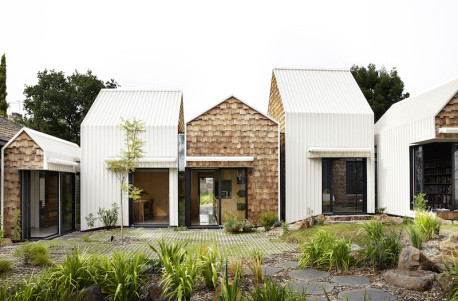
The architecture of ageing
The architecture of ageing
Share
Above: Austin Maynard Architects’ Tower House, photograph by Tess Kelly. Written by Ian Nazareth.
This article originally appeared in AR145 – available now through newsstands and digitally through Zinio.
Designing for an ageing population is synonymous with assisted living and retirement communities, models of isolation and dependency. The economic and financial implications aside, these environments perpetuate an array of particularly ominous conditions.
While ageing is inevitable, there is some anxiety surrounding the mechanisms to manage an ageing demographic. This urgency springs from the unprecedented rate at which the global population is concurrently ageing and urbanising, crucial and inseparable interests. By 2020, over 50 percent of people aged 60 and over will live in an urban environment, and by 2050 2.1 billion people (or 21.5 percent of the population) will be aged over 60, outnumbering those 15 and under. The reciprocity between urbanisation and ageing will necessitate innovative approaches to models of housing, systems of the neighbourhood, transport, healthcare, amenity and the malleability of the urban fabric. With ageing as a keystone, can architecture and creative practices collectively intervene to reimagine the city and suburbia?
Living with the elderly is not a particularly new subject but, rather, nuanced by diverse cultural attitudes and milieu. Asia and the Middle East, in particular, have a legacy of multigenerational models. In China, ‘filial piety’ – a virtue of care for elders – can be traced back to Confucius, and the design of traditional Indian courtyard houses were partly a consequence of the ethos of extended and joint families to support ageing relatives. The somewhat disparaging expression, granny flat, and manifestations of neighbourhood houses, have a history in Australian domestic typologies. In Melbourne, Austin Maynard Architects’ Tower House (2014) sets a precedent for the investigation of the suburban dwelling as grounds for speculation and redefining the relationship of the built environment with an ageing demographic.
Ageing in place, multigenerational living and longevity are conspicuous paradigms observed within contemporary society.
In Australia, merely six percent of the senior population opt for retirement living and five percent choose to reside in assisted living facilities, extraordinary, when confronted by the hurried deployment of such institutions. The overwhelming majority choose to age in place, a phenomenon that vilifies the longstanding discourse of ageing. This could include living independently in private, family or rented homes, in localities they are acquainted with and lifestyles the residents are accustomed to. While such demands strain the existing building stock, new types are to be explored and tested. Whether detached dwelling, townhouse, apartment or otherwise, these homes will be ingrained with a sensibility of scale, self-determined living, adaptability and accessibility. How will such residential projects respond to growing families, or the downsizing of households? How could they advocate for public transport and personal mobility, and ensure access to amenity and service?
Along the banks of the Yarra River at Heidelberg, Melbourne-based practice, ThomsonAdsett, has proposed a vibrant community, Streeton Park, comprising 85 independent living apartments with flexible rooms, shared communal spaces and a wellness hub for residents. While it is located near public transport and the Heide Museum of Modern Art, the limited diversity of the project’s socioeconomics implies a singular narrative that does not stray too far from the traditional model of retirement villages.
Proximity to public transport, amenity and open space, and access to medical and healthcare services are central to designing for demographic change. Smart cities and smart homes remain specious notions, but the convergence of information will transform the way in which we interact with domestic environments and future cities. The spatialisation of virtual systems means that the city can be better understood in real-time and be well-placed to anticipate and respond to emergency services, specialised healthcare and public transport – services that are crucial for an urban ageing population.
As metropolitan regions grow or consolidate, new centralities emerge, seeking out more diverse reactions to people and place. Multigenerational living is a tactical response and one that resonates with a finer grain of demographic inclusion. The internal complexity of a multigenerational program will be amplified when expressed over multiple urban sites and could reorient the hierarchies of the city.
Lacaton Vassal’s Ourcq Jaures Student and Social Housing (2014) project in Paris integrates student dwellings with social dwellings and specialist care homes into a single building. While each typology is designed with the requirements of respective user groups in mind, residents have access to private outdoor spaces and a continuous balcony that unifies the development. Through its materiality and ambition the project asserts an urban identity, but also sits within an extensive plan for the revitalisation and restructuring of the neighbourhood, through social integration.
Lacaton Vassal has assembled a critical body of work focused on socially engaged housing transformations. In refurbishing 530 apartments in an archetypal 1960s tower in Bordeaux, interventions in structure, floor, circulation and façade suggest not only a precision in both analysing and retrofitting the architectural frame, repositioning the building within the urban landscape, but also absorbing and advancing a new internal social dynamic.
Ageing is clumsily equated with retirement; however, increased life expectancy and longevity that points to retirees and an ageing population remaining active in society, is perhaps the zeitgeist. Examples in Burbank, California by social entrepreneur Tim Carpenter (EngAGE) break with convention, reconsidering intergenerational living as centres of learning. Projects are modelled on college campuses, where the adjacency of advanced learning centres and access to educational facilities benefit residents and the community. Considering the constellation of urban and regional university campuses in Australia, could this be a possible model and plausible scenario for housing an ageing population?
The intention is for cities to embody an alternative system of values for demographic transition that could be traced from low-density suburban developments through to dense urban conditions. The city block is a primary site for speculation that will collectively evolve to accommodate a matrix of residential typologies varying in size, but more specifically designed for a wider cross- section of the demographic: from advanced age groups with assisted care provisions, retirees and empty nesters, to young families and students. These projects will be interwoven with multi-modal public transport, a network of open spaces, recreational facilities, co-location of amenity and retail. Such precincts could fold onto a distributed system of healthcare and medical infrastructure. These ideas contest existing models that are less than expedient and in reshuffling the density and intensity of existing programmatic briefs could potentially remap the DNA of the city.
The 2016 International Architecture Exhibition (La Biennale di Venezia) directed by Chilean architect Alejandro Aravena, titled ‘Reporting from the Front’, surveys issues from segregation, housing, peripheries to migration and the participation of communities. It is mobilised by the recognition for architecture to provide a multidimensional response and the scrutiny of emerging fields of action for the discipline.
Beyond disciplinary existentialism the future city requires a more comprehensive approach and sweeping changes in the conceptualisation and delivery of citywide policy frameworks and, eventually, a working model between and across the idiosyncrasies of respective city councils.
The forecast for an ageing demographic and precognition of longevity will challenge the underlying assumptions about society, the capacity of architecture, and the agency of design of the city to suggest behaviour, acclimate to changeability and reconcile shifts. Should architects expect to be agents of and for change, it is essential to mount a challenge to the mythology of architectural method and urban policy process.
The spatial agency for architecture will stimulate the harnessing, mining and manipulation of the future city to develop new taxonomies and typologies of urban prototypes. As a discipline we will be acting with an imperative towards hybridisation and transformation. The inquiry of design for age-friendly cities is, unmistakably, building more dynamic urban environments and facilitating resilient cities.
Subscribe to AR today – available now through newsstands and digitally through Zinio.
You Might also Like


















